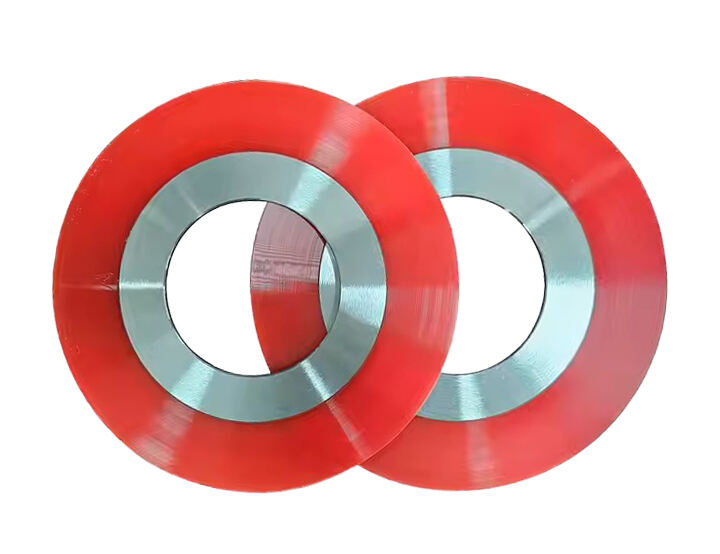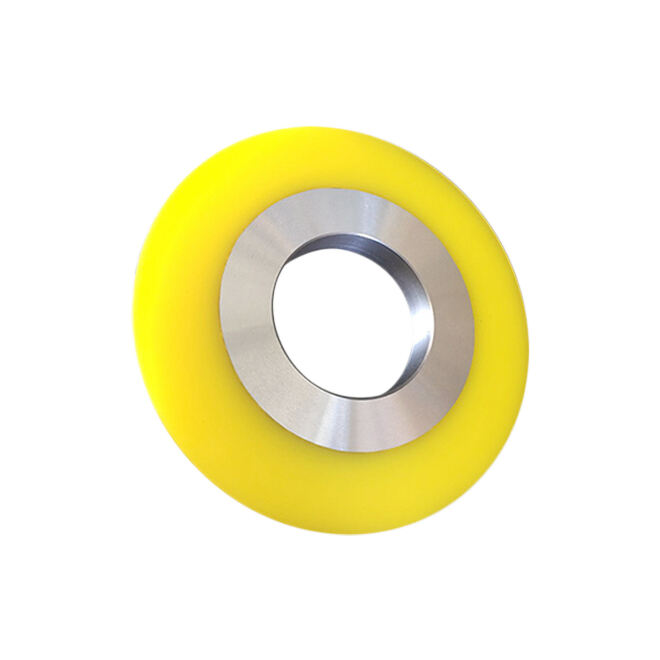What Is the Role of the Slitting Machine Blade Rubber Sleeve on Metal Sheet Slitting and What Is the Impact?
In metal sheet slitting, precision and safety are critical to producing high-quality, consistent results. Among the key components of a slitting machine, the blade rubber sleeve plays a often-overlooked but vital role. This small, flexible component works alongside the slitting blades to protect materials, improve cut quality, and extend blade life. Understanding the role of the blade rubber sleeve and its impact on metal sheet slitting helps operators optimize performance, reduce waste, and avoid costly mistakes. This guide explains the functions of the blade rubber sleeve, how it affects slitting outcomes, and why proper maintenance of these sleeves is essential.
What Is a Slitting Machine Blade Rubber Sleeve?
A slitting machine blade rubber sleeve is a cylindrical or ring-shaped component made from durable rubber or elastomeric materials (like nitrile, silicone, or polyurethane). It is mounted on the slitting machine’s arbor (the rotating shaft) alongside the metal slitting blades. The sleeves are positioned between blades or around blade edges, depending on the machine design, and are designed to withstand the pressure, friction, and contact with metal sheets during slitting.
Rubber sleeves come in various sizes, hardness levels, and thicknesses to match different blade types, metal sheet thicknesses, and slitting requirements. Their flexibility and elasticity make them ideal for adapting to slight variations in material thickness and protecting both the blades and the metal sheets.
Key Roles of the Blade Rubber Sleeve in Metal Sheet Slitting
The blade rubber sleeve performs several critical functions that directly impact the slitting process and the quality of the final product:
1. Protecting Metal Sheets from Damage
Metal sheets—especially thin or coated varieties (like galvanized steel or aluminum)—are prone to scratches, dents, or marring during slitting. The blade rubber sleeve acts as a buffer between the hard metal blades and the metal sheet surface:
- Preventing Scratches: As the metal sheet passes through the slitting machine, the rubber sleeves make contact with the sheet’s surface before or after the blade cuts. Their smooth, flexible surface avoids leaving marks, ensuring the sheet remains visually and functionally intact.
- Avoiding Deformation: Thin metal sheets can bend or warp under the pressure of slitting blades. Rubber sleeves distribute pressure evenly across the sheet, reducing the risk of deformation or creasing that would render the sheet unusable.
- Shielding Coated Surfaces: Coated metals (e.g., painted or galvanized sheets) have delicate finishes. Rubber sleeves prevent the blades or machine parts from scraping off coatings, which would require rework or result in scrapped materials.
2. Stabilizing the Metal Sheet During Cutting
Stability is essential for clean, straight cuts. The blade rubber sleeve helps keep the metal sheet aligned and steady as it moves through the slitting machine:
- Guiding the Sheet: Rubber sleeves create a firm but gentle grip on the metal sheet, guiding it precisely between the slitting blades. This prevents the sheet from shifting or “walking” during cutting, which would cause uneven or jagged edges.
- Reducing Vibration: Slitting blades spin at high speeds, creating vibration that can disrupt the cutting process. Rubber sleeves absorb vibration, minimizing movement of the metal sheet and ensuring the blades cut along the intended path.
- Supporting Thin Sheets: Thin metal sheets (less than 1mm thick) are flexible and prone to sagging. Rubber sleeves provide upward support, keeping the sheet flat against the blades for consistent cut depth.
3. Extending Slitting Blade Life
Slitting blades are expensive, and premature wear increases production costs. The blade rubber sleeve helps protect blades from damage and excessive wear:
- Preventing Blade Chipping: Small debris, burrs, or uneven edges on the metal sheet can chip slitting blades. Rubber sleeves act as a barrier, smoothing out minor imperfections on the sheet before they reach the blade edge, reducing the risk of chipping.
- Reducing Friction: Without rubber sleeves, metal sheets may rub directly against blade holders or machine parts, creating friction that heats the blades. Rubber sleeves reduce this friction, keeping blades cooler and slowing down wear from heat-induced damage.
- Aligning Blades Properly: Rubber sleeves help maintain consistent spacing between blades, ensuring they cut evenly without overlapping or touching each other. This prevents blade-to-blade contact, which can dull edges or cause chips.
4. Controlling Material Waste
Waste from uneven cuts, damaged sheets, or blade errors increases production costs. The blade rubber sleeve minimizes waste by:
- Ensuring Clean Cuts: By stabilizing the sheet and guiding it accurately, rubber sleeves help blades produce straight, burr-free edges. This reduces the need to trim or rework edges, which wastes material.
- Reducing Scrap Sheets: Protected from scratches, dents, or deformation, more sheets meet quality standards, lowering the number of scrapped materials.
- Minimizing Blade Downtime: With blades lasting longer due to reduced wear, there are fewer interruptions for blade changes. This keeps production running smoothly, reducing losses from idle time.

Factors Affecting the Performance of Blade Rubber Sleeves
The impact of blade rubber sleeves depends on several factors, which operators must consider to maximize their effectiveness:
Material of the Rubber Sleeve
- Nitrile Rubber: Offers good resistance to oil and abrasion, making it ideal for slitting oily metal sheets (e.g., cold-rolled steel).
- Silicone Rubber: Withstands high temperatures, suitable for slitting processes that generate heat (e.g., cutting thick metal sheets).
- Polyurethane: Provides excellent durability and flexibility, balancing wear resistance with a gentle grip on delicate metal sheets.
Choosing the right rubber material ensures the sleeve performs well in specific slitting conditions.
Hardness of the Rubber Sleeve
Rubber hardness is measured in Shore A durometer. The right hardness depends on the metal sheet thickness and type:
- Soft Sleeves (50–70 Shore A): Work best for thin or delicate sheets, providing gentle pressure without deformation.
- Hard Sleeves (80–90 Shore A): Offer more stability for thick or rigid metal sheets, ensuring firm guidance during cutting.
Using a sleeve that is too soft for thick sheets may cause instability, while a sleeve that is too hard for thin sheets may scratch or dent the material.
Size and Fit
The rubber sleeve must fit tightly on the machine’s arbor and align correctly with the slitting blades. A loose sleeve can shift during operation, reducing its effectiveness and potentially damaging the sheet or blades. Proper sizing ensures consistent contact with the metal sheet and stable performance.
Maintenance and Wear
Over time, rubber sleeves wear down from friction, exposure to metal particles, or chemical contact (e.g., oils on metal sheets). Signs of wear include cracks, tears, or a rough surface. Worn sleeves lose their ability to protect sheets or stabilize cutting, leading to increased waste and blade damage. Regular inspection and replacement of worn sleeves are essential.
FAQ
How often should blade rubber sleeves be replaced?
Replacement frequency depends on use: in high-volume slitting (daily operation), sleeves may need replacement every 2–4 weeks. For lower-volume use, they can last 1–3 months. Replace sleeves immediately if you notice cracks, tears, or reduced performance (e.g., increased scratches on sheets).
Can the wrong rubber sleeve hardness cause damage to metal sheets?
Yes. A sleeve that is too hard can scratch or dent thin sheets, while a sleeve that is too soft may fail to stabilize thick sheets, leading to uneven cuts. Always match sleeve hardness to the metal sheet thickness.
Are blade rubber sleeves necessary for all types of metal slitting?
While not strictly “necessary,” they are highly recommended. Even for thick, uncoated metal sheets, rubber sleeves reduce blade wear and improve cut stability. For thin, coated, or high-quality sheets, they are essential to prevent damage and waste.
Can rubber sleeves be reused after cleaning?
Minor cleaning (removing metal particles or oil) can extend sleeve life, but once sleeves show signs of wear (cracks, roughness), they must be replaced. Reusing worn sleeves risks poor performance and increased production losses.
What happens if a blade rubber sleeve is missing or damaged during slitting?
Missing or damaged sleeves can cause scratches on metal sheets, uneven cuts, blade chipping, and increased vibration. This leads to higher waste, more frequent blade replacements, and lower-quality output—all increasing production costs.
Table of Contents
- What Is the Role of the Slitting Machine Blade Rubber Sleeve on Metal Sheet Slitting and What Is the Impact?
- What Is a Slitting Machine Blade Rubber Sleeve?
- Key Roles of the Blade Rubber Sleeve in Metal Sheet Slitting
- Factors Affecting the Performance of Blade Rubber Sleeves
-
FAQ
- How often should blade rubber sleeves be replaced?
- Can the wrong rubber sleeve hardness cause damage to metal sheets?
- Are blade rubber sleeves necessary for all types of metal slitting?
- Can rubber sleeves be reused after cleaning?
- What happens if a blade rubber sleeve is missing or damaged during slitting?

